key PONTIAC SOLSTICE 2006 User Guide
[x] Cancel search | Manufacturer: PONTIAC, Model Year: 2006, Model line: SOLSTICE, Model: PONTIAC SOLSTICE 2006Pages: 328, PDF Size: 1.92 MB
Page 57 of 328
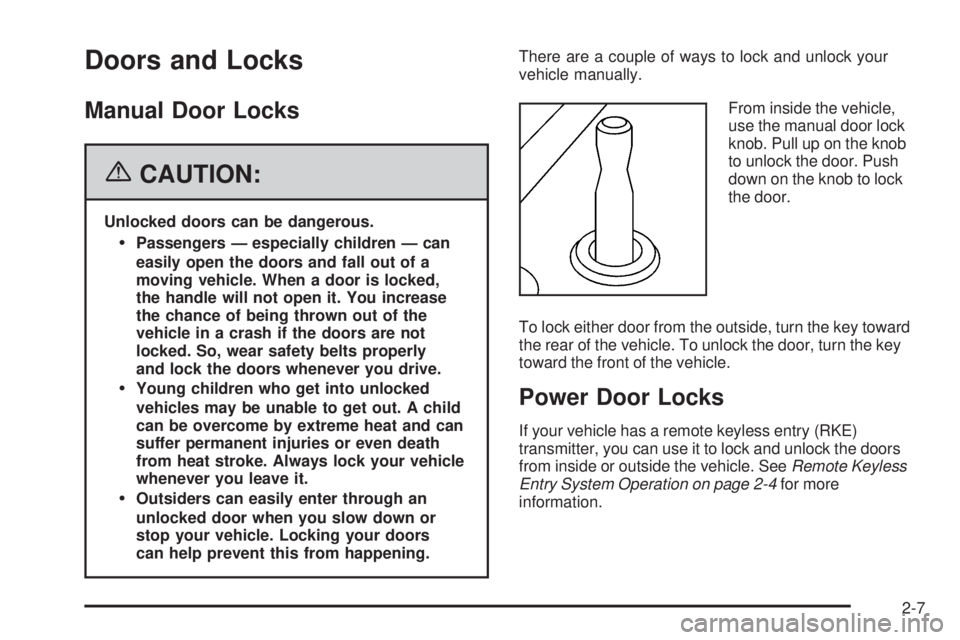
Doors and Locks
Manual Door Locks
{CAUTION:
Unlocked doors can be dangerous.
Passengers — especially children — can
easily open the doors and fall out of a
moving vehicle. When a door is locked,
the handle will not open it. You increase
the chance of being thrown out of the
vehicle in a crash if the doors are not
locked. So, wear safety belts properly
and lock the doors whenever you drive.
Young children who get into unlocked
vehicles may be unable to get out. A child
can be overcome by extreme heat and can
suffer permanent injuries or even death
from heat stroke. Always lock your vehicle
whenever you leave it.
Outsiders can easily enter through an
unlocked door when you slow down or
stop your vehicle. Locking your doors
can help prevent this from happening.There are a couple of ways to lock and unlock your
vehicle manually.
From inside the vehicle,
use the manual door lock
knob. Pull up on the knob
to unlock the door. Push
down on the knob to lock
the door.
To lock either door from the outside, turn the key toward
the rear of the vehicle. To unlock the door, turn the key
toward the front of the vehicle.
Power Door Locks
If your vehicle has a remote keyless entry (RKE)
transmitter, you can use it to lock and unlock the doors
from inside or outside the vehicle. SeeRemote Keyless
Entry System Operation on page 2-4for more
information.
2-7
Page 58 of 328
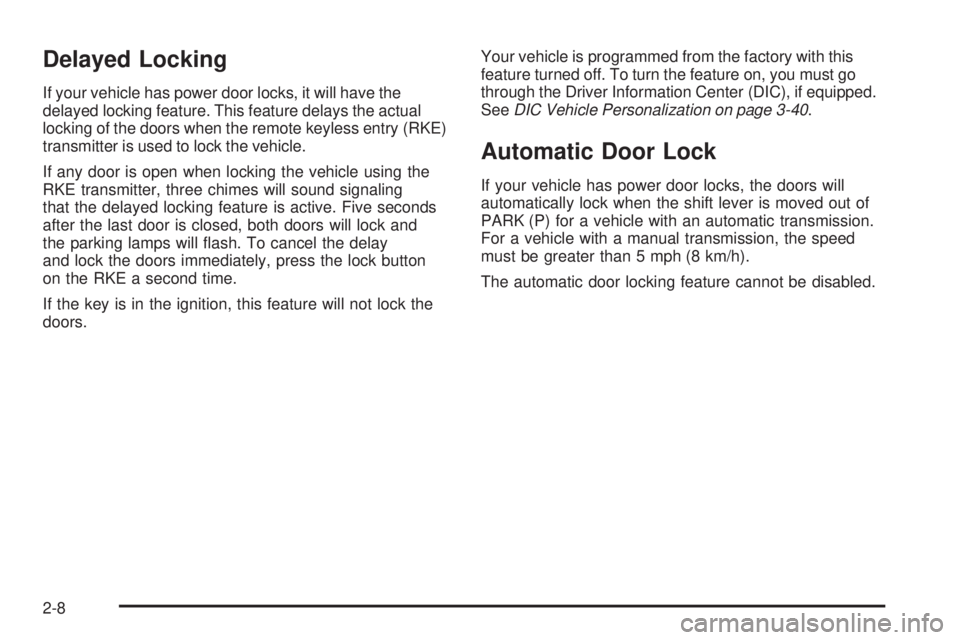
Delayed Locking
If your vehicle has power door locks, it will have the
delayed locking feature. This feature delays the actual
locking of the doors when the remote keyless entry (RKE)
transmitter is used to lock the vehicle.
If any door is open when locking the vehicle using the
RKE transmitter, three chimes will sound signaling
that the delayed locking feature is active. Five seconds
after the last door is closed, both doors will lock and
the parking lamps will �ash. To cancel the delay
and lock the doors immediately, press the lock button
on the RKE a second time.
If the key is in the ignition, this feature will not lock the
doors.Your vehicle is programmed from the factory with this
feature turned off. To turn the feature on, you must go
through the Driver Information Center (DIC), if equipped.
SeeDIC Vehicle Personalization on page 3-40.
Automatic Door Lock
If your vehicle has power door locks, the doors will
automatically lock when the shift lever is moved out of
PARK (P) for a vehicle with an automatic transmission.
For a vehicle with a manual transmission, the speed
must be greater than 5 mph (8 km/h).
The automatic door locking feature cannot be disabled.
2-8
Page 59 of 328
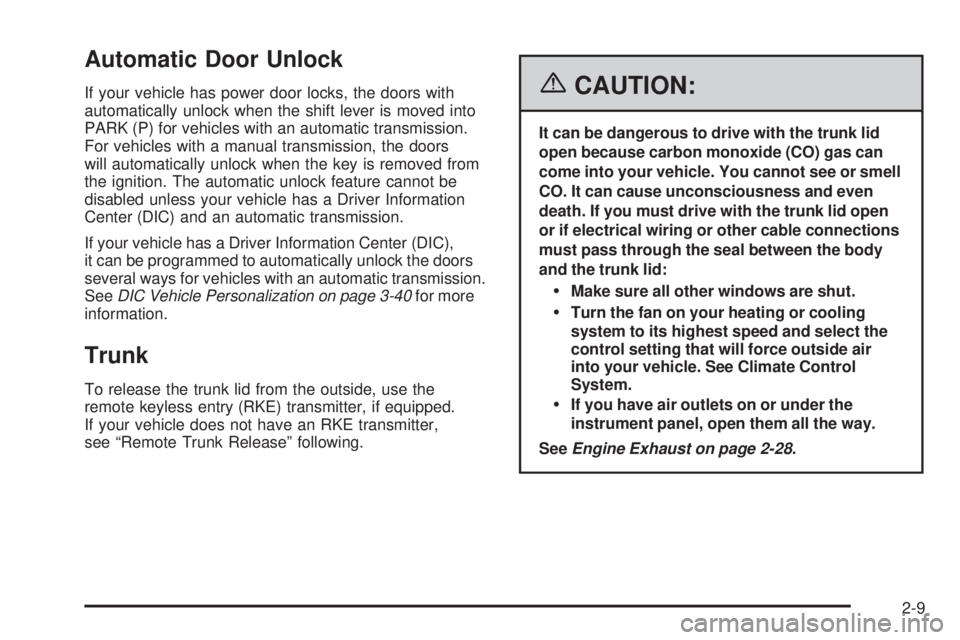
Automatic Door Unlock
If your vehicle has power door locks, the doors with
automatically unlock when the shift lever is moved into
PARK (P) for vehicles with an automatic transmission.
For vehicles with a manual transmission, the doors
will automatically unlock when the key is removed from
the ignition. The automatic unlock feature cannot be
disabled unless your vehicle has a Driver Information
Center (DIC) and an automatic transmission.
If your vehicle has a Driver Information Center (DIC),
it can be programmed to automatically unlock the doors
several ways for vehicles with an automatic transmission.
SeeDIC Vehicle Personalization on page 3-40for more
information.
Trunk
To release the trunk lid from the outside, use the
remote keyless entry (RKE) transmitter, if equipped.
If your vehicle does not have an RKE transmitter,
see “Remote Trunk Release” following.
{CAUTION:
It can be dangerous to drive with the trunk lid
open because carbon monoxide (CO) gas can
come into your vehicle. You cannot see or smell
CO. It can cause unconsciousness and even
death. If you must drive with the trunk lid open
or if electrical wiring or other cable connections
must pass through the seal between the body
and the trunk lid:
Make sure all other windows are shut.
Turn the fan on your heating or cooling
system to its highest speed and select the
control setting that will force outside air
into your vehicle. See Climate Control
System.
If you have air outlets on or under the
instrument panel, open them all the way.
SeeEngine Exhaust on page 2-28.
2-9
Page 63 of 328
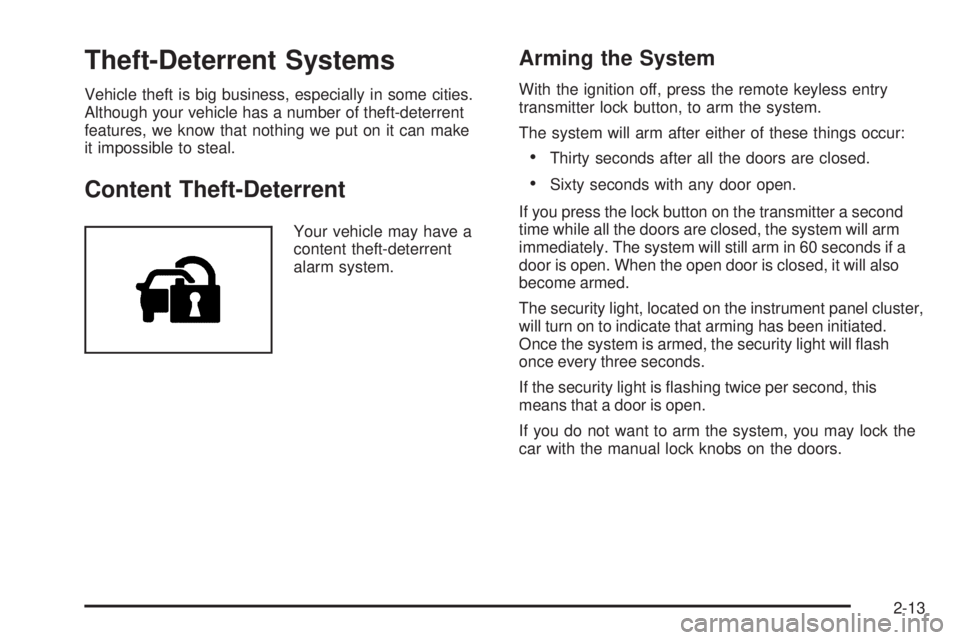
Theft-Deterrent Systems
Vehicle theft is big business, especially in some cities.
Although your vehicle has a number of theft-deterrent
features, we know that nothing we put on it can make
it impossible to steal.
Content Theft-Deterrent
Your vehicle may have a
content theft-deterrent
alarm system.
Arming the System
With the ignition off, press the remote keyless entry
transmitter lock button, to arm the system.
The system will arm after either of these things occur:
Thirty seconds after all the doors are closed.
Sixty seconds with any door open.
If you press the lock button on the transmitter a second
time while all the doors are closed, the system will arm
immediately. The system will still arm in 60 seconds if a
door is open. When the open door is closed, it will also
become armed.
The security light, located on the instrument panel cluster,
will turn on to indicate that arming has been initiated.
Once the system is armed, the security light will �ash
once every three seconds.
If the security light is �ashing twice per second, this
means that a door is open.
If you do not want to arm the system, you may lock the
car with the manual lock knobs on the doors.
2-13
Page 64 of 328

Disarming the System
You can disarm the system by doing any one of the
following:
Press the remote keyless entry transmitter unlock
button.
Turn the ignition on.
If the system is armed and the trunk is opened using the
trunk release button on the transmitter, the system will
temporarily disarm itself and re-arm when the trunk has
been closed. This allows the you to exit the vehicle, lock
the doors using the transmitter, and open the trunk using
the transmitter without having to disarm and re-arm the
system.
Once the system is disarmed, the security light will stop
�ashing.
How the System Alarm is Activated
If the system is armed, it can be activated by either:
Opening the driver’s door or trunk. This will cause a
ten second pre-alarm chirp followed by a thirty
second full alarm of horn and lights.
Opening any other door. This will immediately cause
a full alarm of horn and lights for thirty seconds.
When an alarm event has �nished, the system will
re-arm itself automatically.
How to Turn Off the System Alarm
To turn off the system alarm, do one of the following:
Press the lock button on the remote keyless
entry transmitter. The system will then re-arm itself.
Press the unlock button on the remote keyless entry
transmitter. This will also disarm the system.
Insert the key in the ignition and turn it on. This will
also disarm the system.
How to Detect a Tamper Condition
If you hear three chirps when you press the unlock,
lock, or trunk release buttons on the remote keyless
transmitter, it means that the content theft security
system alarm was activated previously.
PASS-Key®III+
The PASS-Key®III+ system operates on a radio
frequency subject to Federal Communications
Commission (FCC) Rules and with Industry Canada.
This device complies with Part 15 of the FCC Rules.
Operation is subject to the following two conditions:
1. This device may not cause harmful interference.
2. This device must accept any interference received,
including interference that may cause undesired
operation.
2-14
Page 65 of 328

This device complies with RSS-210 of Industry Canada.
Operation is subject to the following two conditions:
1. This device may not cause interference.
2. This device must accept any interference received,
including interference that may cause undesired
operation of the device.
Changes or modi�cations to this system by other than
an authorized service facility could void authorization to
use this equipment.
PASS-Key
®III+ uses a radio frequency transponder in
the key that matches a decoder in your vehicle.
PASS-Key®III+ Operation
Your vehicle is equipped with PASS-Key®III+
(Personalized Automotive Security System)
theft-deterrent system. PASS-Key
®III+ is a passive
theft-deterrent system. This means you do not have to do
anything special to arm or disarm the system. It works
when you insert or remove the key from the ignition.
When the PASS-Key
®III+ system senses that someone
is using the wrong key, it prevents the vehicle from
starting. Anyone using a trial-and-error method to start
the vehicle will be discouraged because of the high
number of electrical key codes.When trying to start the vehicle if the engine does not
start and the security light on the instrument panel cluster
comes on, the key may have a damaged transponder.
Turn the ignition off and try again.
If the engine still does not start, and the key appears to be
not damaged, try another ignition key. At this time, you
may also want to check the fuse, seeFuses and Circuit
Breakers on page 5-78. If the engine still does not start
with the other key, your vehicle needs service. If your
vehicle does start, the �rst key may be faulty. See your
dealer who can service the PASS-Key
®III+ to have a
new key made. In an emergency, contact Roadside
Assistance. SeeRoadside Assistance Program on
page 7-6.
It is possible for the PASS-Key
®III+ decoder to “learn”
the transponder value of a new or replacement key.
Up to 10 keys may be programmed for the vehicle. The
following procedure is for programming additional keys
only. If all the currently programmed keys are lost or do
not operate, you must see your dealer or a locksmith who
can service PASS-Key
®III+ to have keys made and
programmed to the system.
See your dealer or a locksmith who can service
PASS-Key
®III+ to get a new key blank that is cut
exactly as the ignition key that operates the system.
2-15
Page 66 of 328

To program the new key do the following:
1. Verify that the new key has a “+” with a circle
around it stamped on it.
2. Insert the already programmed key in the ignition
and start the engine. If the engine will not start,
see your dealer for service.
3. After the engine has started, turn the key to LOCK,
and remove the key.
4. Insert the key to be programmed and turn it to the
RUN position within �ve seconds of the original key
being turned to the LOCK position.
5. The security light will turn off once the key has
been programmed.
6. Repeat Steps 1 through 5 if additional keys are to
be programmed.
If you are ever driving and the security light comes on
and stays on, you may be able to restart your engine if
you turn it off. Your PASS-Key
®III+ system, however,
is not working properly and must be serviced by
your dealer. Your vehicle is not protected by the
PASS-Key
®III+ system at this time.
If you lose or damage your PASS-Key
®III+ key,
see your dealer or a locksmith who can service
PASS-Key
®III+ to have a new key made.
Starting and Operating Your
Vehicle
New Vehicle Break-In
Notice:Your vehicle does not need an elaborate
break-in. But it will perform better in the long run if
you follow these guidelines for the �rst 500 miles
(805 km):
Do not drive at any one constant speed, fast
or slow.
Do not exceed 70 mph (113 km/h).
Do not make full-throttle starts; also refrain from
using the full throttle while driving. Avoid
downshifting to brake, or slow, the vehicle.
If these break-in procedures are not followed,
the vehicle’s engine, axle, or other parts could
be damaged.
Avoid making hard stops for the �rst 200 miles
(322 km) or so. During this time your new brake
linings are not yet broken in. Hard stops with new
linings can mean premature wear and earlier
replacement. Follow this breaking-in guideline
every time you get new brake linings.
Following break-in, engine speed and load can be
gradually increased.
2-16
Page 67 of 328

Ignition Positions
With the key in the ignition switch, you can turn it to
four different positions.
Notice:Using a tool to force the key from the
ignition switch could cause damage or break the key.
Use the correct key and turn the key only with your
hand. Make sure the key is all the way in. If it is, turn
the steering wheel left and right while you turn the
key hard. If none of this works, then your vehicle
needs service.
9(LOCK):This position locks your steering column.
It is a theft-deterrent feature. You will only be able
to remove your key when the ignition is turned to LOCK.If you have an automatic transmission, the ignition switch
cannot be turned to LOCK unless the shift lever is in
PARK (P).
If you have a manual transmission, the ignition switch can
be turned to LOCK in any shift lever position.
{CAUTION:
If you have a manual transmission removing the
key from the ignition switch will lock the
steering column and result in a loss of ability to
steer the vehicle. This could cause a collision. If
you need to turn the engine off while the vehicle
is moving, turn the key to ACC.
ACC (ACCESSORY):This position operates some of
your electrical accessories. It unlocks the steering wheel
and ignition.
R(RUN):This is the position the switch returns to after
you start your engine and release the switch. The switch
stays in the RUN position when the engine is running. But
even when the ignition is not running, you can use RUN
to operate your electrical accessories and to display
some warning and indicator lights.
2-17
Page 68 of 328

/(START):This position starts the engine. When the
engine starts, release the key. The ignition switch will
return to RUN for normal driving.
A warning tone will sound if you open the driver’s door
while in LOCK or ACC, when the key has not been
removed from the ignition.
Shift Lock Release
The following procedure allows the ignition to be turned
to LOCK and for ignition key removal in case of a dead
battery or low voltage battery.
1. Make sure the shift lever is in PARK (P).2. Using a tool, pry off the cover from the bottom of
the steering column.
3. Place your �nger into the access hole and locate
the plunger.
4. Press and hold the plunger toward the driver’s door
while turning the ignition key to LOCK. Remove
the key.
Have your vehicle serviced at your GM dealer as soon
as possible.
2-18
Page 69 of 328
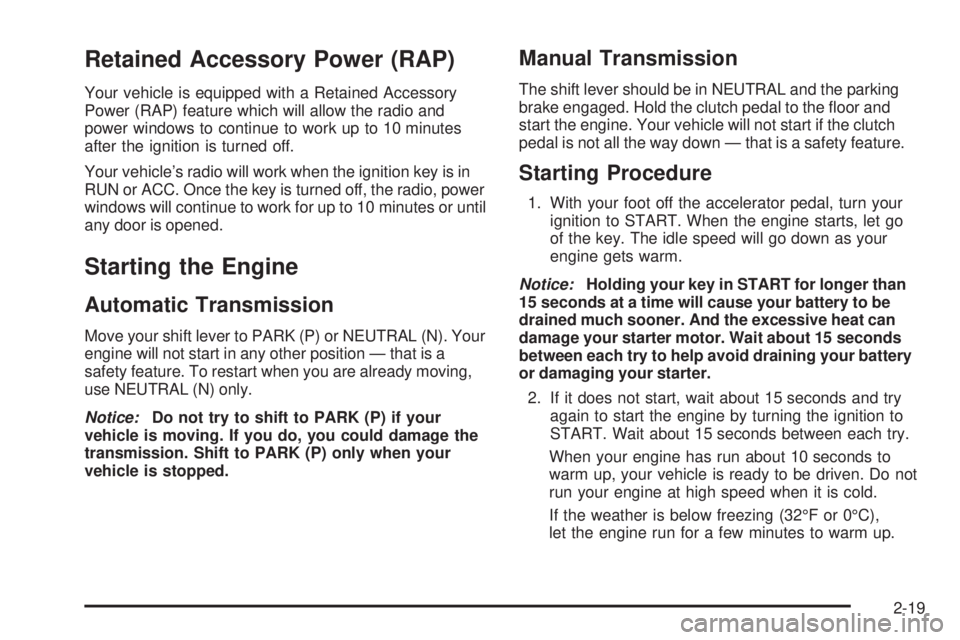
Retained Accessory Power (RAP)
Your vehicle is equipped with a Retained Accessory
Power (RAP) feature which will allow the radio and
power windows to continue to work up to 10 minutes
after the ignition is turned off.
Your vehicle’s radio will work when the ignition key is in
RUN or ACC. Once the key is turned off, the radio, power
windows will continue to work for up to 10 minutes or until
any door is opened.
Starting the Engine
Automatic Transmission
Move your shift lever to PARK (P) or NEUTRAL (N). Your
engine will not start in any other position — that is a
safety feature. To restart when you are already moving,
use NEUTRAL (N) only.
Notice:Do not try to shift to PARK (P) if your
vehicle is moving. If you do, you could damage the
transmission. Shift to PARK (P) only when your
vehicle is stopped.
Manual Transmission
The shift lever should be in NEUTRAL and the parking
brake engaged. Hold the clutch pedal to the �oor and
start the engine. Your vehicle will not start if the clutch
pedal is not all the way down — that is a safety feature.
Starting Procedure
1. With your foot off the accelerator pedal, turn your
ignition to START. When the engine starts, let go
of the key. The idle speed will go down as your
engine gets warm.
Notice:Holding your key in START for longer than
15 seconds at a time will cause your battery to be
drained much sooner. And the excessive heat can
damage your starter motor. Wait about 15 seconds
between each try to help avoid draining your battery
or damaging your starter.
2. If it does not start, wait about 15 seconds and try
again to start the engine by turning the ignition to
START. Wait about 15 seconds between each try.
When your engine has run about 10 seconds to
warm up, your vehicle is ready to be driven. Do not
run your engine at high speed when it is cold.
If the weather is below freezing (32°F or 0°C),
let the engine run for a few minutes to warm up.
2-19